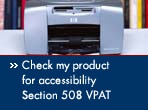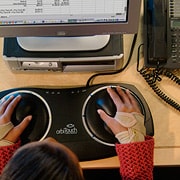 |
» |
|

|
 |
 |
 |
|
 |
|
 |

Are your small business customers aware that there are tax incentives available to help employers cover the cost of accommodations for employees with disabilities and to make their places of business accessible? Be sure you let them know – it could help you sell more!
According to IRS Code Section 44, small businesses that in the previous year earned a maximum of $1 million in revenue or had 30 or fewer full-time employees may take an annual tax credit for making their businesses accessible to persons with disabilities. The credit is 50 percent of expenditures over $250, not to exceed $10,250, for a maximum benefit of $5,000. The credit amount is subtracted from the total tax liability.
The credit is available every year and can be used for a variety of costs such as: - sign language interpreters for employees or customers who have hearing impairments;
-
readers for employees or customers who have visual impairments;
-
the purchase of adaptive equipment or the modification of equipment;
-
the production of print materials in accessible formats (e.g., Braille, audio tape, large print);
-
the removal of barriers, in buildings or vehicles, which prevent a business from being accessible to, or usable by, individuals with disabilities; and
-
fees for consulting services (under certain circumstances.)
Expenses must be paid or incurred to enable a small business to comply with the requirements of the Americans with Disabilities Act.
Get more information about tax incentives for small business accessibility.
» back to top
|
 |

European policies are now recognizing the key role that AT can play in inclusion and fostering independence for people with disabilities. With that in mind, the Association for the Advancement of Assistive Technology in Europe (AAATE) intends to establish a position as the key organization that can advance and consolidate AT within Europe and influence policy makers.
|
|
 |

 |
 |
|

HP Assistive Technology Vendor News is published by the HP Assistive Technology Vendor (HPATV) Program. All rights reserved.
When a company joins the HP Developer & Solution Partner Program (DSPP) and chooses "Assistive Technology" as an application type in the company profile, it becomes a member of the HPATV program. Members’ email addresses are registered with the Developer & Solution Partner Program to receive relevant communications, and they receive an e-mail copy of this newsletter.
Subscribe
To subscribe, click on this link. Select “HPATV newsletter” in the drop-down subject box, and then type your contact information in the message box.
Change your e-mail or unsubscribe
Click on this link to change your subscription information. Select “HPATV newsletter” in the drop-down subject box, and then type your new information in the message box.
Postal Address:
HP Privacy Mailbox
20555 SH 249
MS 040307
Houston, Texas 77070
Privacy statement
|
|
 |
|
|
 |
 |

The AAATE is the interdisciplinary pan-European association devoted to all aspects of assistive technology, such as use, research, development, manufacture, supply, provision and policy. Its mission is “to stimulate the advancement of assistive technology for the benefit of people with disabilities, including elderly people."
Over 250 members from all over Europe and throughout the world currently take part in the AAATE.
Learn more about AAATE
Another European organization that can jump-start your entry into the European market is London-based FAST, the Foundation for Assistive Technology. FAST works with the AT community to support innovation in product development and good practice in service provision.
Learn more about FAST
» back to top |
 |
|
 |

Smart companies are tapping into the largest and fastest-growing market segment in the U.S. and globally: the aging Baby Boomer generation. Consider this…
- In the U.S., the burgeoning boomer market is now 77 million strong.
- It represents more than $2 trillion in annual spending.
- Households headed by someone 40 or older hold 91% of America's net worth.
(source: Kenneth Gilpin, New York Times)
This market has a vast potential need for assistive technology (although they don’t want to call it that). Baby boomers are staying in the workforce longer than previous generations, and many of them need various aids (like screen magnification) to do their work. Even home or personal technology might need adaptations for people over 50. For example, poor eyesight due to presbyopia makes it hard for boomers to see the keys on small devices like cell phones, handheld computers and remote control units. Solutions developed for people with disabilities might be perfect for the broader population of people over 50. Ask yourself: has my product positioning and marketing kept pace with this lucrative market?
» back to top |
 |
|
 |

The Developer and Solution Partner Program (DSPP) provides a broad range of resources to help you develop, market and sell your solutions. For example, your Marketing & Sales benefits include discounts to services that HP believes can provide value to you, including:
-
Website development – get assistance with website graphic design, usability, programming or database development
-
Writing services – work with an agency to develop customer success stories/case studies, web content, white papers, datasheets, newsletter and magazine articles, press releases, blog content and sales materials
- Lead generation direct mail and telemarketing services – use these services to find new customers for your solution or product
DSPP also provides toolkits to help you do things yourself. For example:
Review your full list of sales and marketing benefits from DSPP.
» back to top |
 |
|
 |

Some of our most widely-used technologies originated as adaptive devices, including the telephone, transistor radios, and the typewriter.
Quoted: Bill Abbott, a regulatory lawyer with Bell Canada, discusses an approach that companies can take in justifying accessibility as a requirement when developing new products and services. “Assistive technology is seen as a regulatory obligation, not as something that takes you far or fast towards innovation. You need to change that outlook to seeing it as a business opportunity. You need to put it as a business case with a strategy built into it to get accessibility going, from the executives on down to the front lines. A business case should make money, and that drives innovation—if there’s money in it, people will bring their best brains to it.”
» back to top |
|

